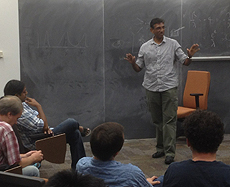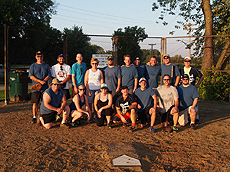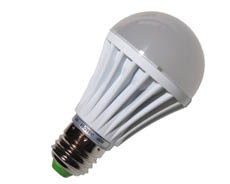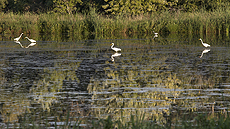|
Monday, Sept. 8
- Breakfast: blueberry crepes
- Breakfast: sausage, egg and cheese croissant
- Philly-style cheesesteak with peppers
- Smart cuisine: chicken creole
- Greek patitsio
- Spicy Asian chicken wrap
- Stir fry sensations
- Corn chowder
- Texas-style chili
- Assorted pizza by the slice
Wilson Hall Cafe menu
|
|
Wednesday, Sept. 10
Lunch
- Chicken piccata with capers
- Angel hair pasta
- Wilted spinach
- Blueberry cobbler
Friday, Sept. 12
Dinner
- Stuffed grape leaves
- Herbed grilled lamb chops
- Horseradish mashed potatoes
- Roasted broccoli
- Baklava
Chez Leon menu
Call x3524 to make your reservation.
|
|
Scientists put their heads together over the unbearable lightness of the Higgs mass
 |
| University of Maryland's Raman Sundrum leads a discussion at the recent Nature Guiding Theory workshop. Photo: Joe Lykken |
A confounding conundrum that has been needling particle physicists for decades was thrust to the fore when the Higgs boson discovery was announced in July 2012: The mass of the Higgs is absurdly low. Why?
Taken alone, the Higgs mass is expected to be 1019 GeV. That's a 10 followed by 19 zeros. But something — some unknown behavior — must be locking in the Higgs mass at 125 GeV. According to the known laws of physics, it is no more natural that the Higgs weigh as little as 125 GeV than an ice cube remain at 0 degrees Celsius on a hot day or that a pencil stand alone on its tip for hours on end.
That there must be something else out there holding the Higgs in place is known as the naturalness principle. This has driven many of the new physics searches at the Large Hadron Collider, which have so far yielded null results.
At last month's Nature Guiding Theory workshop, the first of its kind, more than 70 scientists hailing from across the United States, as well as from Europe and Asia, gathered at Fermilab to debate possible solutions to the massive problem.
"There were some radical ideas, but maybe radical is the order of the day," said workshop co-organizer Prateek Agrawal of Fermilab. "Rotten tomatoes were brought up at every talk, but none were thrown. It was lively and well received."
The ideas were necessarily far-reaching to be able to account for such a chasm between expectation and data.
Over the last few decades, scientists have published numerous schemes to balance the book on the Higgs mass. Extra dimensions might do it. So might supersymmetry, the idea that every known particle has a massive superpartner, or compositeness, the idea that particles thought to have no component parts might actually be divisible into smaller pieces after all. None of these have yet been found.
"We're digging in the far-out nooks and crannies," Agrawal said.
The workshop, funded by the URA Visiting Scholars program and supported by Fermilab's Theory Group, gave scientists an opportunity to hash it all out, comparing their ideas against the data from the LHC experiments.
"Everybody approached this issue with a new sense of humility. We're stuck in self-questioning and confusion," said Fermilab's Felix Yu, workshop co-organizer. "We want to know what the data is saying about this principle and whether it's a good way of moving forward in this field."
He added, "Being in this era — when it's possible we have to upend decades of really foundational ways of thinking about this problem — is scary and exciting."
—Leah Hesla
|
Final Force, Fermilab Softball League champions
 |
| The Final Force. Top row: Tony Busch, Eric Korzeniowski, Dave Baird, Jean Reising, Jon Ylinen, Beau Harrison, Denny McAuliff, Dan Johnson, Kelly Sedgwick, Greg Vogel. Bottom row: Dave Hockin, Maddie Wolter, Katie Kosirog, Duane Newhart, Andrew Dalesandro, Chris Greer, Bob Zwaska. Photo: Mordecai Thetford |
Congratulations to the Final Force, this season's Fermilab Softball League champions. Kudos go to all the league's teams for an excellent season: Big Bangers, Boomers, Final Force, Lightning Rods and Prairie Fire.
|
Chameleons and holograms: Dark energy hunt gets weird
From New Scientist, Sept. 3, 2014
A light in the darkness can come from unexpected places. Unusual experiments for probing dark energy seem set to revolutionise our understanding of this mysterious force.
In Chicago last week, the world's largest meeting of cosmologists debated two of the forces that could push the universe apart: inflation, the proposed period of exponential expansion that the universe went through immediately after the big bang; and dark energy, the present-day force thought to be responsible for pushing the cosmos outward at an ever increasing rate.
Read more
|
Research aimed at the heart of the sun
From The New York Times, Sept. 1, 2014
With the aid of a powerful instrument, researchers have detected subatomic particles produced by fusion reactions at the very core of the sun.
The particles are neutrinos, and the ones detected in this study are low in energy but abundant in number, said Andrea P. Pocar, a physicist at the University of Massachusetts, Amherst. The neutrinos are formed by a fusion reaction between two protons at the core of the sun; they travel to Earth in just eight minutes (almost at the speed of light).
Read more
|
|
How to screw in a light bulb
 |
| An LED bulb provides up to 50,000 hours of lighting and uses much less energy than an incandescent or compact fluorescent bulb. This can add up to savings of $340 over the lifetime of the LED bulb. Photo courtesy of ledbulbsandlights.com |
Have you ever heard the joke, "How many environmentalists does it take to screw in a light bulb?" With recent advancements in lighting technology, an environmentalist might rewrite the joke to ask, "How many light bulbs does a smart consumer use over a lifetime?". Their answer would be, "Very few, because a smart consumer would use an LED bulb."
According to EPA's ENERGY STAR Current, lighting accounts for 12 to 30 percent of energy use in the United States. Lighting uses about 12 percent of the total energy in a home, which is more than a refrigerator, dishwasher and clothes washer use combined. In a commercial building, it accounts for 30 percent (about the same as an air conditioning system).
Although Fermilab's accelerator complex makes up the majority of the lab's total energy use, all of the lab's 362 buildings and 70 trailers require lighting. Using smart lighting is one of the easiest ways to reduce energy use and save money in existing buildings. One can install timers or motion detectors, make maximum use of natural light, or simply use a different type of bulb.
LED, or light-emitting diode, bulbs are gaining popularity as a versatile and energy-efficient product. When LED standard-use light bulbs were first introduced at retail stores a few years back, prices were high, as much as $100 each, and functionality was low. Now companies are making better and more affordable products, at anywhere from $8 to $20 per bulb.
Compact fluorescent bulbs use less energy than traditional incandescent bulbs but contain mercury, have specific disposal rules, are made of glass and are more fragile, take a while to turn on, are not dimmable, and emit ultraviolet light. LEDs use 70 to 90 percent less energy and last 25 times longer than an incandescent light bulb and use half as much energy and last eight times longer than a compact fluorescent bulb. That means you would have to purchase only one LED during the period you would typically buy 25 incandescent light bulbs or eight compact fluorescent bulbs, saving up to $340 in bulb purchases and energy costs over the lifetime of the bulb. Your investment could pay off in less than a year.
When shopping for electronics, appliances and light bulbs, look for the ENERGY STAR symbol. Choosing an ENERGY STAR product can be slightly more expensive up front but can offer savings in electricity bills over the lifetime of the product. In an EPA ENERGY STAR challenge for retailers to promote and sell LEDs over other types of lighting between Earth Day 2013 and Earth Day 2014, 20 million ENERGY STAR-certified LED light bulbs were sold, with a cost savings of $118 million each year in energy costs. This is equivalent to the greenhouse gas emissions of 3.5 million vehicles.
The answer to the original joke above is, "None. An environmentalist uses the sun." But we all use artificial light, and we all benefit from using less energy, so let's try to rewrite the joke!
—Katie Kosirog
|
Egrets across the pond
 |
| Egrets wade in Dusaf Pond. Photo: Marty Murphy, AD |
|
Beginning six-week shutdown for upgrades and maintenance
Fermilab's accelerator complex entered a six-week shutdown period on Friday, Sept. 5. The lab is also making allowances for a possible seventh week of maintenance to allow for contingencies.
During the shutdown period, laboratory personnel will perform maintenance on water, power, vacuum and other systems. They will also install devices that will allow a future 8-GeV beam to be delivered to the MC-1 Building, where the muon experiments are housed.
The accelerator complex is planned to come back online in stages with the Main Injector and Recycler by Oct. 27.
|
|